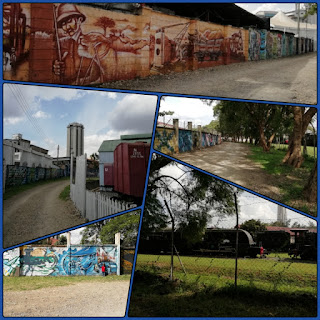During our trip to Nairobi we made a historical trip, yeah to the museum. That too, to the Railway museum. This museum comprises of locomotives and photos of ships which were part of the East African Railways which operated the railways and the harbours of Kenya and Uganda.
As soon as you enter the museum campus, you can see its walls painted artistically. At first it is the art museum that welcomes you, numerous young art students are seen jamming and painting, what talents!
Next is the reception to the museum. Entrance ticket is 600 shillings each for non-residents. In the same building we can go through the photographs of the locomotives and trains belonging to the early 20th century. All related items belonging to the British era can be seen as exhibits.
We can also see the railway routes of East African Railways (EAR), Tanganyika Railways and Kenya Uganda Railways (KUR). Many artefacts are carefully chosen and can be seen here only. The bicycle designed for running on track is a unique one. Also there to be witnessed are the old railway station clocks, lamps, bells, lights with station master, tortoise century, model ships, etc..
The harbours of EAR includes the ones used for ferrying in the surrounding lakes - Victoria, Albert, Kyoga and Nile. So the ships that were deployed to operate in these lakes are also prototyped here. Fire fighting equipments of those days are also displayed. One will feel enthusiastic to see the ship steering wheel from India.
There are also the speedometer, single line train signals, old phone instruments and journal polishers. Some steam operators are still seem to be active in Kenya today. Some of the porcelain items belonging to the Queen are exhibited too for public view.
British are credited for the railway network in India and same effort have gone into Africa also during their time. Many of the items in the African Railways can be seen to have come from India.

This place is just next to the Nairobi railway station and often less crowded so we can go around leisurely. A must visit for history lovers.
Feeling nostalgic about the childhood toy trains?
As soon as you enter the museum campus, you can see its walls painted artistically. At first it is the art museum that welcomes you, numerous young art students are seen jamming and painting, what talents!
Next is the reception to the museum. Entrance ticket is 600 shillings each for non-residents. In the same building we can go through the photographs of the locomotives and trains belonging to the early 20th century. All related items belonging to the British era can be seen as exhibits.
We can also see the railway routes of East African Railways (EAR), Tanganyika Railways and Kenya Uganda Railways (KUR). Many artefacts are carefully chosen and can be seen here only. The bicycle designed for running on track is a unique one. Also there to be witnessed are the old railway station clocks, lamps, bells, lights with station master, tortoise century, model ships, etc..
The harbours of EAR includes the ones used for ferrying in the surrounding lakes - Victoria, Albert, Kyoga and Nile. So the ships that were deployed to operate in these lakes are also prototyped here. Fire fighting equipments of those days are also displayed. One will feel enthusiastic to see the ship steering wheel from India.
There are also the speedometer, single line train signals, old phone instruments and journal polishers. Some steam operators are still seem to be active in Kenya today. Some of the porcelain items belonging to the Queen are exhibited too for public view.
British are credited for the railway network in India and same effort have gone into Africa also during their time. Many of the items in the African Railways can be seen to have come from India.

Outside this building we can see a garage with EAR trains preserved on tracks and few more trains of KUR and Tanganyika standing on tracks outside. This is just a great collection of old days trains seen on tracks. It takes a couple of hours to go through the whole museum and one is taken back in times. The Curator office was close that day due to holiday.
This place is just next to the Nairobi railway station and often less crowded so we can go around leisurely. A must visit for history lovers.
Feeling nostalgic about the childhood toy trains?











Comments